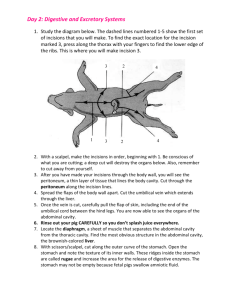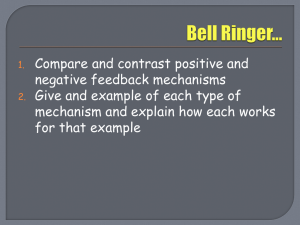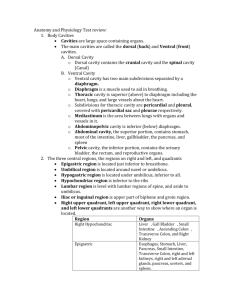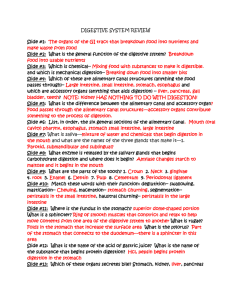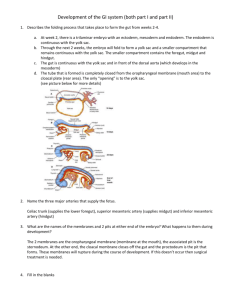Anatomy and Histology of the Digestive System Nearly all portions of
advertisement
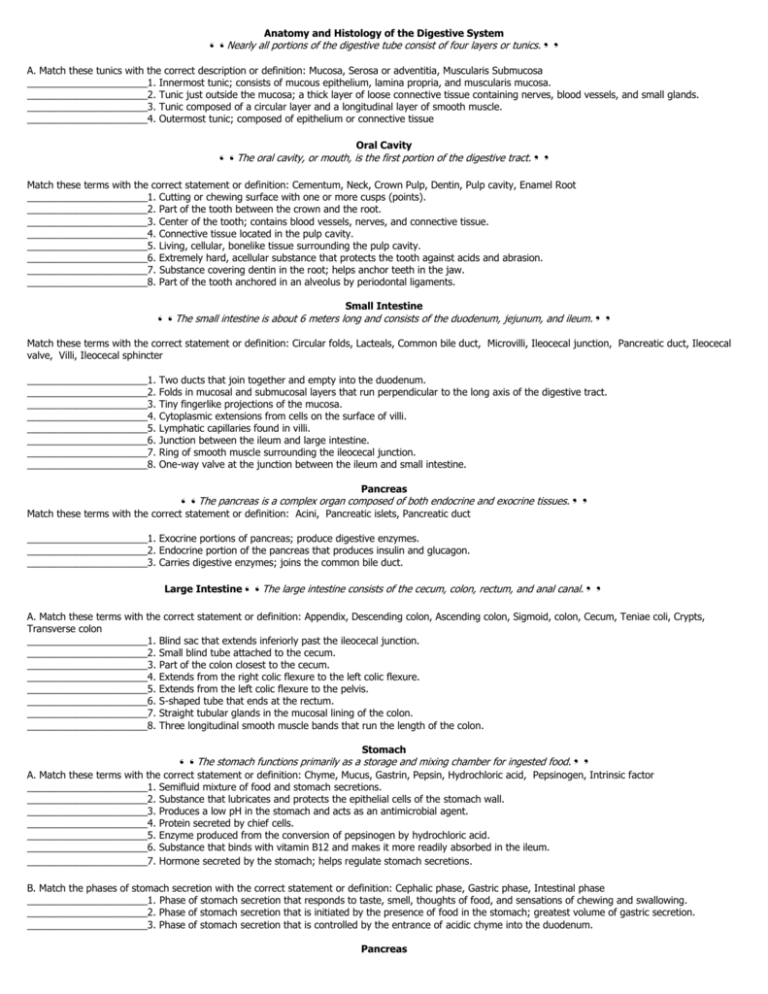
Anatomy and Histology of the Digestive System ❛❛Nearly all portions of the digestive tube consist of four layers or tunics.❜❜ A. Match these tunics with the correct description or definition: Mucosa, Serosa or adventitia, Muscularis Submucosa ______________________1. Innermost tunic; consists of mucous epithelium, lamina propria, and muscularis mucosa. ______________________2. Tunic just outside the mucosa; a thick layer of loose connective tissue containing nerves, blood vessels, and small glands. ______________________3. Tunic composed of a circular layer and a longitudinal layer of smooth muscle. ______________________4. Outermost tunic; composed of epithelium or connective tissue Oral Cavity ❛❛The oral cavity, or mouth, is the first portion of the digestive tract.❜❜ Match these terms with the correct statement or definition: Cementum, Neck, Crown Pulp, Dentin, Pulp cavity, Enamel Root ______________________1. Cutting or chewing surface with one or more cusps (points). ______________________2. Part of the tooth between the crown and the root. ______________________3. Center of the tooth; contains blood vessels, nerves, and connective tissue. ______________________4. Connective tissue located in the pulp cavity. ______________________5. Living, cellular, bonelike tissue surrounding the pulp cavity. ______________________6. Extremely hard, acellular substance that protects the tooth against acids and abrasion. ______________________7. Substance covering dentin in the root; helps anchor teeth in the jaw. ______________________8. Part of the tooth anchored in an alveolus by periodontal ligaments. Small Intestine ❛❛The small intestine is about 6 meters long and consists of the duodenum, jejunum, and ileum.❜❜ Match these terms with the correct statement or definition: Circular folds, Lacteals, Common bile duct, Microvilli, Ileocecal junction, Pancreatic duct, Ileocecal valve, Villi, Ileocecal sphincter ______________________1. ______________________2. ______________________3. ______________________4. ______________________5. ______________________6. ______________________7. ______________________8. Two ducts that join together and empty into the duodenum. Folds in mucosal and submucosal layers that run perpendicular to the long axis of the digestive tract. Tiny fingerlike projections of the mucosa. Cytoplasmic extensions from cells on the surface of villi. Lymphatic capillaries found in villi. Junction between the ileum and large intestine. Ring of smooth muscle surrounding the ileocecal junction. One-way valve at the junction between the ileum and small intestine. Pancreas ❛❛The pancreas is a complex organ composed of both endocrine and exocrine tissues.❜❜ Match these terms with the correct statement or definition: Acini, Pancreatic islets, Pancreatic duct ______________________1. Exocrine portions of pancreas; produce digestive enzymes. ______________________2. Endocrine portion of the pancreas that produces insulin and glucagon. ______________________3. Carries digestive enzymes; joins the common bile duct. Large Intestine❛❛The large intestine consists of the cecum, colon, rectum, and anal canal.❜❜ A. Match these terms with the correct statement or definition: Appendix, Descending colon, Ascending colon, Sigmoid, colon, Cecum, Teniae coli, Crypts, Transverse colon ______________________1. Blind sac that extends inferiorly past the ileocecal junction. ______________________2. Small blind tube attached to the cecum. ______________________3. Part of the colon closest to the cecum. ______________________4. Extends from the right colic flexure to the left colic flexure. ______________________5. Extends from the left colic flexure to the pelvis. ______________________6. S-shaped tube that ends at the rectum. ______________________7. Straight tubular glands in the mucosal lining of the colon. ______________________8. Three longitudinal smooth muscle bands that run the length of the colon. Stomach ❛❛The stomach functions primarily as a storage and mixing chamber for ingested food.❜❜ A. Match these terms with the correct statement or definition: Chyme, Mucus, Gastrin, Pepsin, Hydrochloric acid, Pepsinogen, Intrinsic factor ______________________1. Semifluid mixture of food and stomach secretions. ______________________2. Substance that lubricates and protects the epithelial cells of the stomach wall. ______________________3. Produces a low pH in the stomach and acts as an antimicrobial agent. ______________________4. Protein secreted by chief cells. ______________________5. Enzyme produced from the conversion of pepsinogen by hydrochloric acid. ______________________6. Substance that binds with vitamin B12 and makes it more readily absorbed in the ileum. ______________________7. Hormone secreted by the stomach; helps regulate stomach secretions. B. Match the phases of stomach secretion with the correct statement or definition: Cephalic phase, Gastric phase, Intestinal phase ______________________1. Phase of stomach secretion that responds to taste, smell, thoughts of food, and sensations of chewing and swallowing. ______________________2. Phase of stomach secretion that is initiated by the presence of food in the stomach; greatest volume of gastric secretion. ______________________3. Phase of stomach secretion that is controlled by the entrance of acidic chyme into the duodenum. Pancreas ❛❛The exocrine secretions of the pancreas include bicarbonate ions and pancreatic enzymes.❜❜ A. Match these enzymes with the correct statement or definition: Lipases, Pancreatic amylase, Nucleases Trypsin and chymotrypsin ______________________1. Major proteolytic enzymes secreted by the pancreas. ______________________2. Continues polysaccharide digestion that started in the oral cavity. ______________________3. Lipid-digesting enzymes. ______________________4. Enzymes that break down DNA and RNA. Match these terms with the correct parts labeled in figure Circular muscle ______________________1 Intramural plexus Longitudinal muscle ______________________2 Mucosa Muscularis ______________________3 Serosa Submucosa ______________________4 ______________________5 ______________________6 ______________________7 Match these terms with the correct parts labeled in figure Cementum ______________________1 Crown Cusp ______________________2 Dentin Enamel ______________________3 Gingiva Neck ______________________4 Periodontal ligaments Pulp cavity ______________________5 Root ______________________6 ______________________7 ______________________8 ______________________9 ______________________10 Match these terms with the correct parts labeled in figure Body ______________________1 Cardiac region Fundus ______________________2 Gastroesophageal opening Lower esophageal sphincter ______________________3 Pyloric opening Pyloric region ______________________4 Pyloric sphincter Rugae ______________________5 ______________________6 ______________________7 ______________________8 ______________________9 Match these terms with the correct parts labeled in figure Bile canaliculi Central vein Hepatic cords Hepatic sinusoid Hepatocyte Liver lobule Portal triad ______________________1 ______________________2 ______________________3 ______________________4 ______________________5 ______________________6 ______________________7


